Performance Retrospective: AMD’s Radeon HD 7970M
by Jarred Walton on June 21, 2013 5:25 PM ESTValue/Medium 1366x768 Gaming Performance
We’ll start off with our “Value” settings, which consist of 1366x768 resolution and roughly Medium detail settings in the tested titles. This represents the sort of settings you’d be likely to use on an iGPU like the HD 7660G or Intel’s HD 4000 (maybe—HD 4600 is possibly a better bet) to get a reasonable >30 FPS out of most titles. Several of the games we’re using now are quite demanding, however, so iGPUs may not be able to provide an acceptable experience unless you really turn down the details and resolution. Here’s what performance looks like:
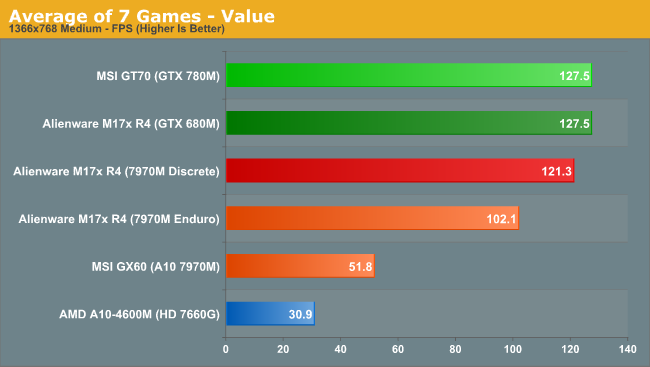

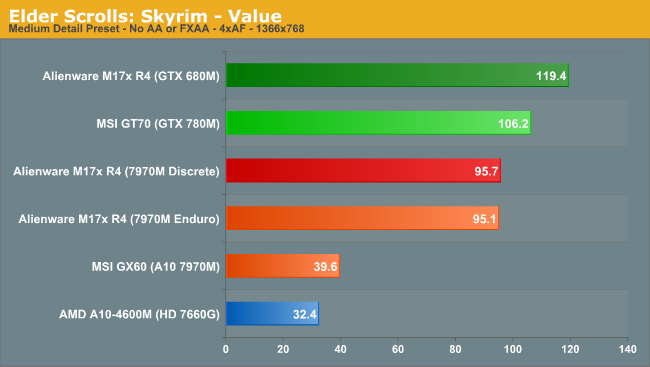

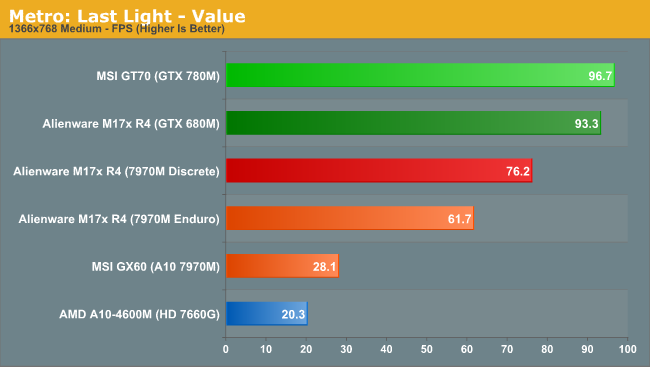

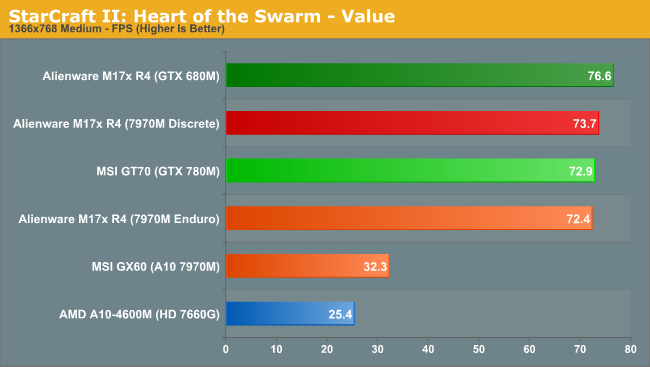
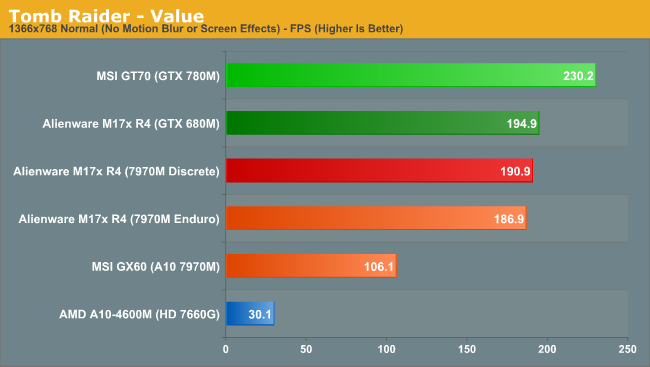
When the HD 7970M first hit notebooks over a year ago, the performance potential seemed lacking compared to the actual hardware. Based on the desktop Pitcairn core, HD 7970M should provide roughly the same performance as the desktop HD 7870 (it’s clocked 15% lower than 7870 on the core, though, so it’s closer to the HD 7850 and GTX 660). The reality is that where the HD 7850 typically competes well against NVIDIA’s desktop GTX 660, on laptops the GTX 680M often blasted the HD 7970M at launch. Many pointed to Enduro as a primary culprit, and while the situation has improved over the past 12 months, even now we can still see a periodic performance deficit from Enduro.
Going over the specifics, on the M17x R4 the discrete mode 7970M ends up being 24% faster in Bioshock, tied in Skyrim, 43% faster in GRID 2, 24% faster in Metro, 54% faster in Sleeping Dogs, tied in StarCraft II, and tied in Tomb Raider. The deficit largely exists in situations where you’re getting >60 FPS, e.g. at lower detail settings and a lower resolution, but that’s obviously not the only factor as Tomb Raider basically elicits no penalty and yet runs at over 180 FPS. While I don’t have the ability to do comparable testing with NVIDIA’s Optimus, I know at one point there were instances where Optimus was slower, but those issues have largely been fixed as far as I can tell. On AMD’s Enduro, that’s clearly not the case with the latest beta drivers.
Incidentally, the bandwidth used to shuttle frames over to the system RAM for display by the iGPU shouldn’t be a limiting factor. Consider as an extreme example a simple graphics benchmark like 3DMark03, where the Wings of Fury test can easily hit >500 FPS at 1366x768. That works out to roughly 2GBps of bandwidth over the PCIe bus, but an x16 slot offers far more bandwidth than that so 2GBps to transfer fames to system RAM shouldn’t present a problem. With the resolutions and frame rates we’re looking at here (a maximum of 1366x768 at <200 FPS), transferring the frames to system RAM uses just 840MBps, so that shouldn’t be a bottleneck.
Moving on to the Intel i7 vs. AMD A10 match up, things are actually worse. We can’t disable Enduro on the GX60, so we’ll just compare Enduro scores for the GX60 and M17x. The Intel platform in this case comes out 79% faster in Bioshock, 140% faster in Skyrim, 85% faster in GRID 2, 120% faster in Metro, 124% faster in Sleeping Dogs, 124% faster in StarCraft II, and 76% faster in Tomb Raider. On average, that works out to a margin of victory of 97%—basically twice as fast. Also of note is that on the GX60, the 7970M is only outperforming the integrated 7660G by 67% on average, so clearly there are other bottlenecks coming into play.
Figuring it was possible the single fan cooling setup in the GX60 is preventing the APU from hitting higher Turbo Core speeds, I logged the various clock speeds using HWiNFO64 and ran through the Bioshock Infinite and Skyrim (extended duration) benchmarks. Maximum CPU clocks reported throughout testing were at a steady 2.7GHz; the APU definitely didn’t hit maximum Turbo Core, but that's only for single-threaded workloads and the 2.7GHz clock is for two or more threads; regardless, it’s not running at the base 2.3GHz, so Turbo or throttling isn't the problem. Similarly, APU temperatures remained below 70C throughout testing, so cooling isn’t limiting performance either. Richland is supposed to be better about hitting its maximum turbo speeds, so potentially that alone could enable it to be 10-15% faster in games like Skyrim and StarCraft II, but the 2-thread turbo speed of Richland is probably similar to Trinity so the gain could prove to be less than 5%. GPU utilization of the HD 7970M during these tests was also rather low at around 35-55%, which isn’t all that uncommon at lower detail settings when the GPU isn’t being pushed hard. Whatever the cause, the fact is that at medium detail settings in most games, the A10-4600M (possibly in combination with Enduro) appears to be a bottleneck on the HD 7970M’s performance.
Wrapping up our look at the Value/Medium settings, if we compare NVIDIA vs. AMD there’s not a lot to say. At these settings, the 680M, 7970M, and 780M are basically taking a siesta. On average, the 680M ends up 5% faster than the best 7970M result and the 780M is tied with the 680M. Looking at individual game results there’s a bit more variation, however. Against the 680M, the 7970M (discrete mode) is generally quite close, with AMD getting minor victories in Bioshock and Sleeping Dogs; minor losses in GRID 2, StarCraft II, and Tomb Raider; and larger 20-25% losses in Skyrim and Metro. The GTX 780M numbers aren't too meaningful, thanks to the test system issues, but Tomb Raider immediately stands out as a game that does't appear to hit the CPU much at all.The 780M is actually slower than the 680M in some of the tests, but it does pull off a 21% lead over the 7970M in Tomb Raider—a game that tends to be very GPU intensive and very light on the CPU.










58 Comments
View All Comments
JarredWalton - Friday, June 21, 2013 - link
Actually, there aren't many Llano + dGPU laptops that got sold I don't think, so I imagine people that own SNB + AMD dGPU are a larger audience (think HP Envy 15 owners). I still think it could happen, but it's a question of whether or not AMD even wants to try. Given the continued driver issues with Enduro, I'm guessing not.Bob Todd - Saturday, June 22, 2013 - link
Yeah, unfortunately I'm the Envy 15 owner from the other Enduro articles :). On a side note before I bitch some more, thanks for keeping us updated on the progress of the driver updates. A bit tangential, but I think this issue also highlights one of the many reasons the rebadging done by both AMD and Nvidia is so anti-consumer. I'm a geek and I read sites like Anandtech, and I go look up mobile GPUs on Notebookcheck before purchasing anything to make sure I know what lies beneath some shiny new part number. But only some tiny percentage of consumers will do that. The overwhelming majority will just see "Radeon 7690M" and assume it's a new part, and that it will be supported like a new part (i.e. readily available driver updates). They shouldn't have to scour the web to find out that only 77XX and above parts are actually "new" stuff, and that they are boned for driver updates with anything below that magical line that someone in marketing decided was the right thing to do. It's intentionally deceptive, and I wish they'd both cut that crap out. I'm sure the revenue forecasts from their financial analysts would make them disagree.billus - Friday, June 21, 2013 - link
Am I the only one who is amazed at how ugly these laptops are? I find it difficult to be enthused about a laptop that looks like it was made from Chinese moss. And I'm the target audience, having paid between $4K and $5K for most of my laptops.silenceisgolden - Friday, June 21, 2013 - link
These laptops don't have a target audience, so design really doesn't matter. If these companies wanted their laptops to be bought in any great quantity they would think about design.Wreckage - Friday, June 21, 2013 - link
At the end of the day AMD's drivers are still an anchor dragging them down.transphasic - Saturday, June 22, 2013 - link
This is not surprising to me, as I had expected this to be the case by now- 9 months later. AMD has, for the gazillionth time, dropped the ball on FIXING Enduro, which they have had all the time in world to do so these last 14 months, but haven't.It's a pretty safe guess that they never will, and as for me from now on- it's Nvidia all the way, and I am never looking back.
Good-bye AMD...
DigitalFreak - Friday, June 21, 2013 - link
I guess Dell got sick of dealing with the Enduro issues as well. The new Alienware 17 comes with Nvidia cards. :-)Dustin Sklavos - Friday, June 21, 2013 - link
The 780M results here are *seriously* not reflective of the 780M's performance, just the crippled MSI GT70. I have my old Alienware M17x R3 being retrofitted with a 780M courtesy of NVIDIA as we speak and should be able to post more realistic 780M performance numbers before the month is out.On any benchmark graph where the 680M performs faster than the 780M, you can safely assume the 780M is being limited by the GT70 and will perform at *least* as well as the 680M in a Clevo or Alienware chassis.
Meaker10 - Saturday, June 22, 2013 - link
When I get my msi gt60 3k edition (2880x1620 ips panel) im going to enjoy showing you what it can really do and how much it will tear your m17x into tiny pieces. ;)Dustin Sklavos - Saturday, June 22, 2013 - link
How's your e-peen?